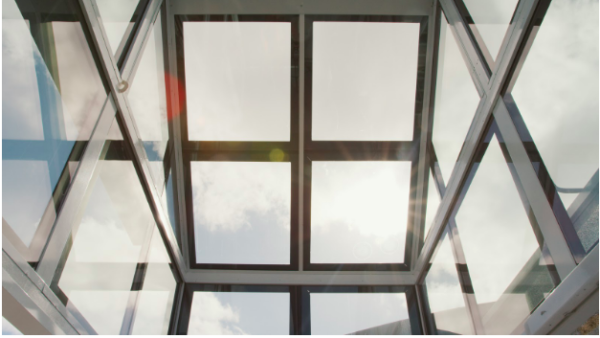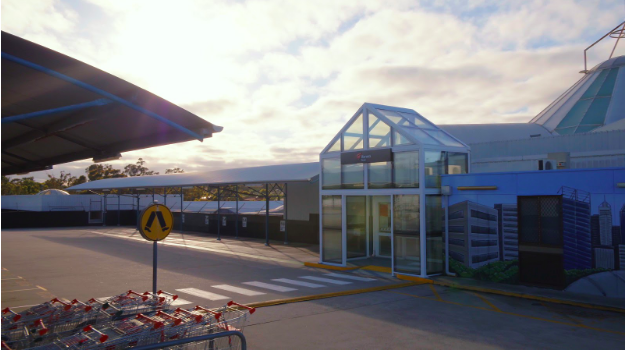Fully transparent solar-energy-gathering glass has taken ClearVue Technologies years to refine in collaboration with scientists at Edith Cowan University’s Electron Science Research Institute.
“The Warwick Grove Centre project represents a major milestone for the company,” says Victor Rosenberg, the ASX-listed company’s Executive Chairman.
“By integrating our solar glass into the atrium entrance at this Centre, we are now able to demonstrate how ClearVue’s technologies can be deployed as skylights and building facades in commercial and retail applications,” he said yesterday in an ASX announcement.
Like most solar panels, ClearVue PV windows have a sandwich construction. But between its two glass panels, inorganic nanoparticles are incorporated into a polyvinyl butyral interlayer, and the interior-facing surface of the inside glass layer is coated with a spectrally selective film.
When sunlight, made up of ultraviolet (UV) light, infrared (IR) light and visible light, strikes the glass, 70% of visible light passes through all layers, while 90% or more of the UV and IR light is reflected off the spectrally selective film, and scattered by the inorganic nanoparticles to the edges of the glass where it’s collected by photovoltaic CIGS (copper indium gallium selenide) cells that produce electricity.

Photo: ClearVue
Generating capacity is currently around 30 watts per square metre. “We anticipate the 26 insulated glass units (IGUs) installed at Warwick Grove as part of this trial will generate up to 1 Mwh each year which will help us create shared value for our customers, retailers, investors and the broader community,” says Justin Mills, Vicinity Centres’ Executive General Manager or Shopping Centre Management.
The atrium panels charge a battery that then powers the structure’s lighting, outside signage and a display screen inside the centre that provides information on power generated, energy saved and carbon offsets.
The structure of the panels also confers greater insulation than conventional glass, and has been found to save up to 40% on a building’s heating, cooling and lighting costs.
“Using ClearVue technology in glass atriums, skylights and facades could enable us to further expand our industry-leading solar program beyond the roof space that’s currently available,” says Mills.
Vicinity Centres — which has $27 billion of retail assets under management across 67 Australian shopping centres, including Chadstone Shopping Centre in Melbourne, and Chatswood Chase in Sydney — is investing $73 million to install solar panels on various centre and carpark rooftops. The rollout of of 31 MW of generation across 22 centres is expected to be complete this year, and will reduce energy drawn from the grid by up to 40%, says Mills.
If the Warwick Grove atrium trial is successful, Vicinity is likely to use ClearVue PV’s clear glass panels and currently more efficient traditional solar panels wherever each makes sense.
ClearVue Technologies in the meantime, anticipates that ongoing R&D will bring the capacity of each square metre of clear glass panelling up to 50 MW. Its clear-glass panels currently have a projected lifespan of 20 years.
In September 2019, ClearVue signed an agreement with Perth-based yStop to integrate its transparent PV panels into yStop’s illuminated street signs and bus-stop structures.
The Warwick Grove atrium is the largest structure so far to be constructed from ClearVue panels, and the first to incorporate different panel shapes.
Future applications include glass curtain walls, such as form the outer surface of office towers, turning their vast surfaces into insulated, electricity-generating powerhouses. Grid-independent greenhouses for horticulture and agriculture are another potential application.
This content is protected by copyright and may not be reused. If you want to cooperate with us and would like to reuse some of our content, please contact: editors@pv-magazine.com.









3 comments
By submitting this form you agree to pv magazine using your data for the purposes of publishing your comment.
Your personal data will only be disclosed or otherwise transmitted to third parties for the purposes of spam filtering or if this is necessary for technical maintenance of the website. Any other transfer to third parties will not take place unless this is justified on the basis of applicable data protection regulations or if pv magazine is legally obliged to do so.
You may revoke this consent at any time with effect for the future, in which case your personal data will be deleted immediately. Otherwise, your data will be deleted if pv magazine has processed your request or the purpose of data storage is fulfilled.
Further information on data privacy can be found in our Data Protection Policy.